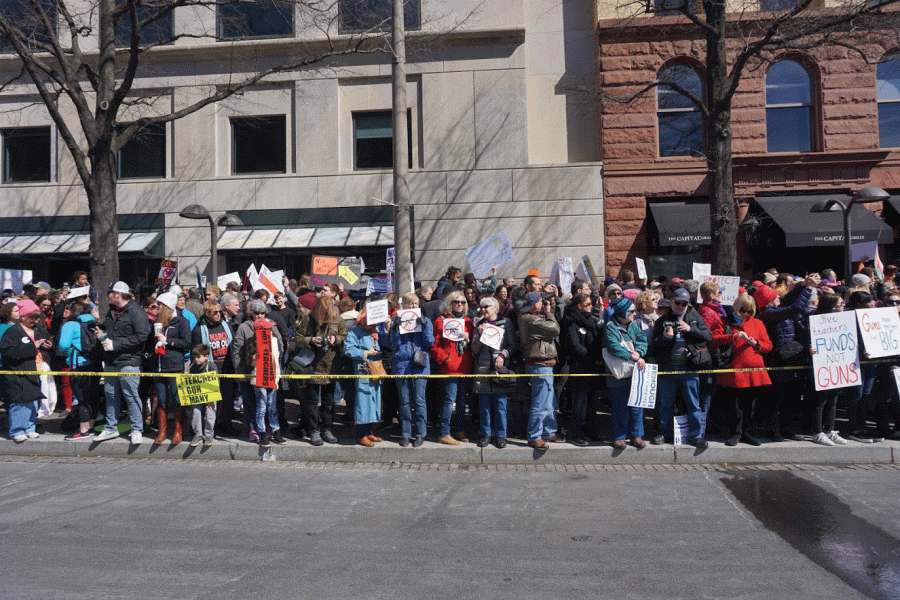Colgate Students Join the March for Our Lives Movement in D.C.
Chants, hashtags and mantras, such as “Time’s up,” “Enough is enough,” “Never again” and “Vote them out,” rang throughout the streets of Washington, D.C. as hundreds of thousands of protesters marched down Pennsylvania Avenue during March For Our Lives on Saturday, March 24. Starting as early as 7 a.m., people organized in front of the main stage in the shadow of Capitol Hill. Everywhere you looked, people were en route to the march.
“[The March For Our Lives is] created by, inspired by and led by students across the country who will no longer risk their lives waiting for someone else to take action to stop the epidemic of mass school shootings that has become all too familiar. In the tragic wake of the seventeen lives brutally cut short in Florida, politicians are telling us that now is not the time to talk about guns. March For Our Lives believes the time is now,” the March For Our Lives mission statement reads.
While the march was taking place, Congress was on recess and President Trump was in Florida. Nonetheless, the protesters were knocking on the doors of the White House and Capitol Hill.
The march was not so much a march, but rather the unity of people, standing together in solidarity and in support of eliminating gun violence. Although the march was coordinated mainly by students affected by the recent school shooting at Marjory Stoneman Douglas High School in Parkland, Florida, it was in response to all gun violence across the nation. There have been countless shootings and massacres, ranging from the 2017 Las Vegas concert massacre and the 2012 Aurora movie theater shooting to the everyday mass-gun violence that plagues cities like Chicago and Baltimore.
The March For Our Lives brought together people from all ages, races, classes and backgrounds to support a change that many people feel is long overdue. The march in Washington, D.C. started with a live performance of the song “Rise Up” by Andra Day, featuring Common.
One of the first speakers, Marjory Stoneman Douglas student Cameron Kasky, said, “Welcome to the revolution.” Kasky reminded the audience that the youth are the change. This event was mostly organized by youth, who as a generation have experienced a disproportionately large amount of gun violence.
Between speeches, protesters chanted sayings like, “Hey hey, ho ho, the NRA has got to go.” Displayed on jumbotrons, cameras captured the crowd and particpants’ signs.
Some people put their hands up, with “Don’t Shoot” written on their palms. Other people had signs, showing their support, outrage and protest through art.
“Everyday shootings are everyday problems,” Trevon Bosley said. Bosley, a young man from Chicago, spoke on the gun violence in his city and the reasons why gun violence is so extreme in cities like Chicago.
Edna Chavez, a Mexican teenager from Los Angeles, also gave an emotional speech on youth leadership and the tragedies disproportionately affecting people of color.
She argued that students should feel empowered and supported in their schools.
“It is normal to see flowers honoring the lives of black and brown youth that have lost their lives to a bullet,” Chavez said.
In addition, eleven-year-old Naomi Wadler also reflected on the importance of having this march.
“I am here today to acknowledge and represent the African American girls whose stories don’t make the front page of every national newspaper. These stories don’t lead on the evening news,” Wadler said.
Wadler’s speech acknowledged a demographic that is frequently neglected from the news.
In between the massacres, she explained, there is violence that predominantly affects minorities and largely goes unnoticed by the media and law enforcement.
Emma Gonzalez ended the speeches with a two minute speech followed by a four minute silence, which added up to the time it took for the shooter at Parkland to kill the 17 students at Marjory Stoneman Douglas. This left much of the crowd in tears.
“Since the time that I came out here, it has been 6 minutes and 20 seconds… Fight for your lives before it’s someone else’s job,” Gonzalez said.
Following in the footsteps of the March for Science and the Women’s March, the March For Our Lives reflects a trend in society: namely, activism and a fight for equality, rights, justice and understanding.
During one speech, Martin Luther King Jr.’s nine year old granddaughter, Yolanda Renee King, came on stage and led the march in a chant that went: “Spread the word! Have you heard? All across the nation, we are going to be a great generation!”
Colgate students who attended the march reflected on the experience.
“What resonated most with me about the March was the turnout, to be frank. I think 800,000 [people] showed up. And it’s nice to see such a diverse turnout in one place,” first-year Bilal Boussayoud said.
Sophomore Diana Flores described the most powerful moments of the day for her.
“First, when eleven-year-old Naomi Wadler represented the ‘African American girls whose stories don’t make the front page of every national newspaper.’ I mean, to hear such a powerful speech from an eleven-year-old girl really ripped my heart, and the hearts of others, apart. To be confronted with this reality by someone whose life is supposed to be full of innocence and childhood was brutal. The second was Sam Fuentes, a Parkland Survivor who still bore the scars of the attack on her face, leading all 800,000 of us in a happy birthday for her friend, Nick Dworet who, had he not been murdered on February 14, would have turned 18 the day of the march. Singing that song with thousands of other voices for someone who was no longer alive, was for me the pinnacle of human sadness,” Flores said.
Contact Tristan Niskanen at [email protected].







